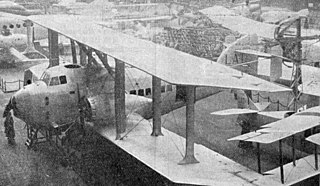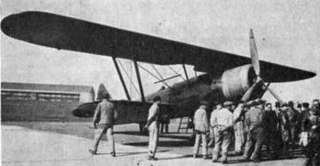
The Latécoère 4 was a three-engined, 15-passenger biplane built in France in the early 1920s. It proved difficult to fly and was discontinued, though a second machine was completed as the Latécoère 5 bomber.

The Potez 37 was a two-seat, long range reconnaissance aircraft built to compete for a French government contract. It flew in mid-1930 but did not win the competition, so only two were completed.

The Potez-CAMS 161 was a large, French six-engined flying boat airliner, designed to operate on the North Atlantic routes that were opening up in the late 1930s. Its development was almost halted by World War II. Just one was built and partially tested before its destruction by Allied forces near the war's end.

The Potez VIII was a French training aircraft which first flew in 1920. Originally it had a very unusual vertical inline engine and a four-wheeled undercarriage, though the production version was more conventional.

The Potez 40 was a French three-engine, braced high-wing monoplane designed and built in response to a French government programme for colonial transport and policing aircraft duties.

The Potez 31 was a prototype French two-seat night fighter, flown in about 1928, intended to fill the Cn.2 specification for the Armee de l'Air. Only one was built.
The Villiers 26 was a French naval seaplane which used Handley Page slats to provide the wide speed range required for escort and patrol duties. It was tested, behaved satisfactorily but received no production order.
The Latham E-5 was a large French Naval four engine biplane flying boat, flown in 1925. It was successfully tested but only one was built.

The Amiot 110-S was an all-metal, amphibious military flying boat built in France in the 1930s. It was intended as a maritime reconnaissance and medium bomber aircraft but only two were built.
The Bassou Rubis (Ruby) was a low power, robust French aircraft designed for basic training and touring.
The Romano R.5 was a French reconnaissance flying boat built in 1932. It had a parasol wing, a single engine and hull stabilizing sponsons. Only one was built.
The Potez 51 was a 1930s French intermediate trainer, intended to replace the ageing Potez 25 which had sold worldwide. It did not go into production.

The Potez 50 or Potez 50 A2 was a French two seat military multi-role aircraft, first flown in 1931. It did not go into service but seven variants using five different engines were produced, one of them setting several speed with useful load records and another, the Potez 506, setting three altitude world records.

The Weymann-Lepère WEL-80 R.2 was a French two seat reconnaissance aircraft built to compete for a 1928 government contract. It was not successful and did not enter production.

The Wibault 260 R.2 was a contender for a French government contract for a long range, two seat reconnaissance aircraft, issued in 1928. There were eight prototypes in the 1931-2 contest and the Wibault was not selected for production.

The Albatros L 83 Adler was a small, fast transport aircraft for passengers, mail or other cargo, flown in Germany in 1931. Two were built.
The Latham L.1 was a French competitor in the 1923 Schneider Trophy race. It was a twin engine, biplane flying boat, built by Société Latham.
The Potez 24 A.2 was a mid-1920s French biplane intended to replace the Potez 15 as an army observation aircraft. The further improved and larger Potez 25 was preferred for production.

The Hanriot H.34 was a basic trainer designed in France in 1924 which did not reach production. It was a parasol wing aircraft, seating two in tandem.

The CAMS 54 was a strengthened and more powerful version of the French CAMS 51 civil transport and naval reconnaissance flying boat, developed for transatlantic flights. It is sometimes referred to as the 54 GR.













